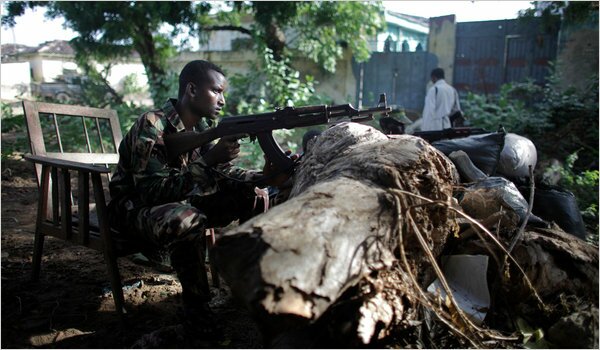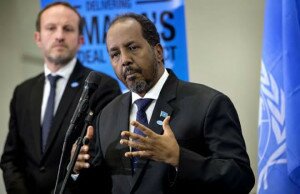Lush Land Winds Through a Ravaged Capital
Mogadishu’s Frontline
By JEFFREY GETTLEMAN New York Times — MOGADISHU, Somalia — There is a certain spot in this war-ravaged city that is unusually quiet and profoundly lush, where the trees are older and dripping with vines and where the branches interlace over the road, creating a canopy that filters the usually harsh equatorial sun into something softer. The leaves here seem a brighter, glossier version of themselves. The grasses are long and thick, perfect to hide in.

A Somali soldier on the front line this month. About 200 feet separates a small government-controlled enclave from insurgents.
This is Mogadishu’s frontline. A no man’s land perhaps 200 feet wide of blasted-out buildings and overgrown bush, it snakes a jagged path across the city, separating a small, besieged enclave controlled by the government from thousands of radical Islamist insurgents. Part of the contested territory happens to cut through the Taleex neighborhood, which used to be one of the city’s grandest, “a neighborhood of haves,†as one young Somali put it, a place of huge, once-beautiful Italianate villas that are now abandoned and freckled with gunfire.
But the eerie beauty here is misleading. Hundreds of men on either side of this line are hunkered down behind tree trunks and chipped plaster walls, squinting at one another through their gun sights. The hush can be instantly shattered by ear-splitting bazookas that shake the ground and send birds screeching from the trees.
“You better be careful,†says Mohamed Mahamoud, a government commander. “The Shabab are just 50 meters away.â€
The neighborhood is deserted and unkempt because it has been a frontline area for several years now, and all the residents have fled.
And the geography tells a story: despite millions of dollars from the United States and the United Nations; despite the fact that the insurgents are poisonously divided and widely reviled; despite Somalia’s president, Sheik Sharif Sheik Ahmed, coming into office more than a year ago with some of the highest hopes this country has had for a leader since Somalia’s central government collapsed in 1991, the frontline has barely budged.
A much-anticipated government offensive to liberate Mogadishu has yet to happen. Somalia’s government is still mostly holed up in a hilltop palace and fighting for survival in the wrecked neighborhoods below, like Taleex. Were it not for the thousands of Ugandan and Burundian peacekeepers in Mogadishu, the hilltop palace would fall, too. Probably within hours.
There is not a lot of good news coming out of the palace these days. A few weeks ago, some of the president’s closest men abruptly resigned, including Hassan Moallim Mohamoud, a Western-educated, devoutly religious confidant who seemed to be a true believer in Sheik Sharif’s moderate Islamist leadership. Not so long ago, Mr. Hassan held court in the presidential guest house, plying visitors with heaping plates of dates and cool glasses of mango juice as he explained how Sheik Sharif’s transitional government would be different from the 14 failed transitional governments that came before it.
Western diplomats now sound dispirited — and totally frustrated. When one was recently asked why the government offensive had not begun, he vented: “These guys can’t get their act together. It’s as simple as that.â€
Somalia’s Parliament building, which sits in an especially shot-up stretch of downtown, was recently repainted for the first time in years. But inside, it is a mess. Lawmakers have been caught up in a particularly bitter round of infighting (partly over what to do about the prime minister, whom the president recently tried to fire before backing down). Many Parliament members are now falling under the spell of Sharif Hassan Sheik Adan, a wily, illiterate livestock trader who was elected speaker last month. Considered one of the country’s most powerful men, and very close to Ethiopia, he seems to have little experience — or interest — in building democratic institutions.
Another potential setback is the looming departure of Ahmedou Ould-Abdallah, the United Nations’ top envoy for Somalia. For nearly the past three years, Mr. Ould-Abdallah has been one of Somalia’s most passionate advocates, organizing conference after conference, constantly flying to New York to keep the Security Council’s attention on this country and coordinating efforts of all the disparate players involved with Somalia: the United States, the European Union, Ethiopia, the Arab League and the African Union, to name a few. Replacing him is a little-known Tanzanian diplomat with experience in humanitarian affairs, possibly a signal of where the future focus will be.
For now, though, all eyes are on the battlefield.
And on the frontline, crouched down with the government troops, one quickly notices that there are no radios, no medics, no food, really, no transportation sergeants or supply captains, no lieutenant colonels or colonels. The troops are divided between a couple of graying men who call themselves commanders and hundreds of foot soldiers, including several children, which brings up another glaring problem (besides the child soldiers): there is no middle management.
As Ken Menkhaus, a professor at Davidson College in North Carolina who specializes in Somalia, has put it, the Somali government is an hourglass, with “a whole bunch of ministers at the top, a whole bunch of soldiers at the bottom and nothing in between.â€
Somalia’s friends are urgently trying to address this void. For example, the European Union is training hundreds of noncommissioned officers in Uganda right now, trying to prepare a professional backbone to stiffen Somalia’s rank and file.
There are a few specks of hope, or at least normalcy. Money-changers now hang out at the airport, a sign, perhaps, that more visitors with dollars are passing through Mogadishu. For the first time in years, there is an airport duty-free shop, which sells iPods and sunglasses.
But the reality — as shown by that stubborn frontline, which in many places is manned not by officially trained troops but by loosely commanded, government-allied militias — is that Somalia’s transitional government is still on life support.
And the conventional wisdom that the United States and others will back that transitional government to the bitter end because they are terrified of the alternative — a Somalia ruled by the Shabab, the country’s leading insurgent group, which is openly aligned with Al Qaeda — may be changing.
Some Somali analysts are now contemplating a new approach known as “constructive disengagement,†which calls for the international community to disentangle itself from Somali politics while continuing to provide humanitarian aid and conducting the occasional special forces raid against known terrorists.
“Doing less is better than doing harm,†wrote Bronwyn E. Bruton in a special report for the Council on Foreign Relations, who is the driving force behind this new theory.
Ms. Bruton argues that outside efforts to shape Somalia’s politics have failed miserably and that the time may soon come for Somalis to fight it out among themselves.
“Unless there is a decisive change in U.S., U.N. and regional policy,†she wrote, “ineffective external meddling threatens to prolong and worsen the conflict, further radicalize the population and increase the odds that Al Qaeda and other extremist groups will eventually find a safe haven in Somalia.â€
__
NYTimes
Comments
comments
 Calendar
Calendar






































